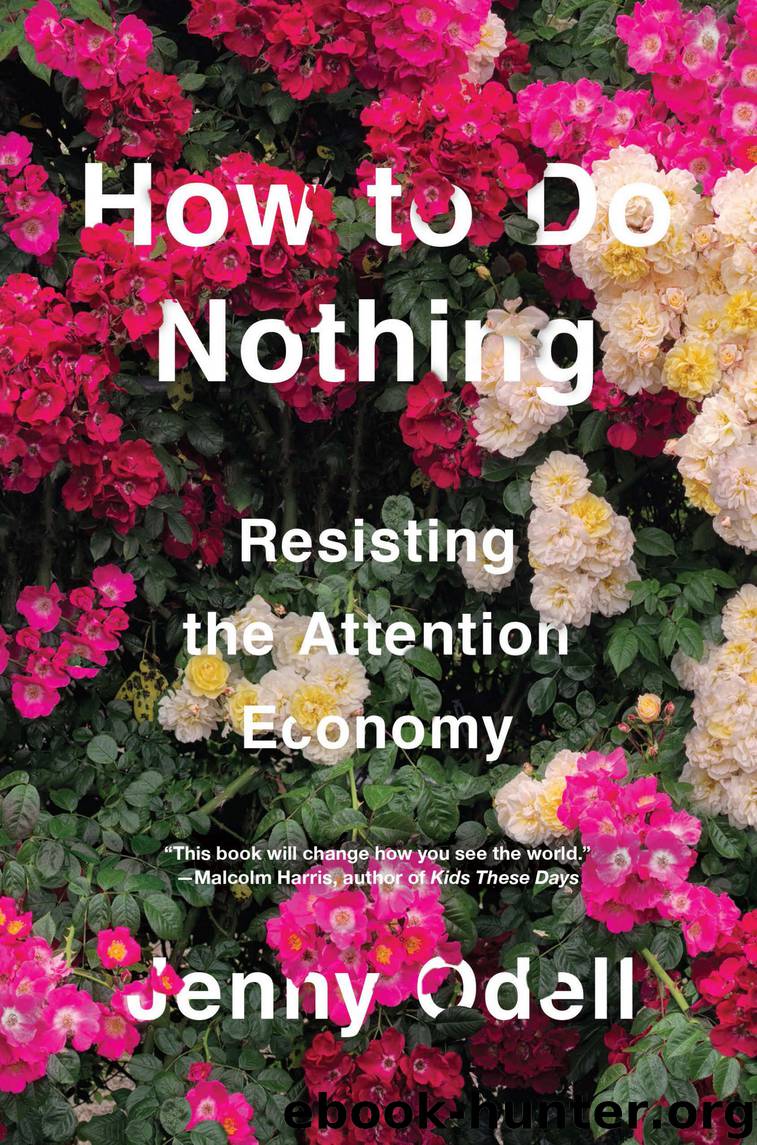How to Do Nothing by Jenny Odell

Author:Jenny Odell
Language: eng
Format: epub, mobi
Publisher: Melville House
Published: 2019-04-08T16:00:00+00:00
* * *
—
ANYONE WHO HAS experienced this unmooring knows that it can be equally exhilarating and disorienting. There is more than a touch of delirium in William Blake’s description when he invites us “[to] see a World in a Grain of Sand / And a Heaven in a Wild Flower / Hold Infinity in the palm of your hand And Eternity in an hour.” This way of looking, in which we are Alice and everything is a potential rabbit hole, is potentially immobilizing; at the very least, it brings us out of step with the everyday. Indeed, the only real drama of The Exchange happens between the protagonist and everyone else, especially his girlfriend, to whom his actions appear insane.
So why go down the rabbit hole? First and most basically, it is enjoyable. Curiosity, something we know most of all from childhood, is a forward-driving force that derives from the differential between what is known and not known. Even morbid curiosity assumes there is something you haven’t seen that you’d like to see, creating a kind of pleasant sensation of unfinished-ness and of something just around the corner. Although it’s never seemed like a choice to me, I live for this feeling. Curiosity is what gets me so involved in something that I forget myself.
This leads into a second reason to leave behind the coordinates of what we habitually notice: doing so allows one to transcend the self. Practices of attention and curiosity are inherently open-ended, oriented toward something outside of ourselves. Through attention and curiosity, we can suspend our tendency toward instrumental understanding—seeing things or people one-dimensionally as the products of their functions—and instead sit with the unfathomable fact of their existence, which opens up toward us but can never be fully grasped or known.
In his 1923 book I and Thou, the philosopher Martin Buber draws a distinction between what he calls I-It and I-Thou ways of seeing. In I-It, the other (a thing or a person) is an “it” that exists only as an instrument or means to an end, something to be appropriated by the “I.” A person who only knows I-It will never encounter anything outside himself because he does not truly “encounter.” Buber writes that such a person “only knows the feverish world out there and his feverish desire to use it…When he says You, he means: You, my ability to use!”9
In contrast to I-it, I-Thou recognizes the irreducibility and absolute equality of the other. In this configuration, I meet you “thou” in your fullness by giving you my total attention; because I neither project nor “interpret” you, the world contracts into a moment of a magical exclusivity between you and me. In I-Thou, the “thou” does not need to be a person; famously, Buber gives the example of different ways of looking at a tree, all but one of which he classifies as I-It. He can “accept it as a picture,” describing its visual elements; he can consider an instance of a species, an expression of natural law, or a pure relation of numbers.
Download
This site does not store any files on its server. We only index and link to content provided by other sites. Please contact the content providers to delete copyright contents if any and email us, we'll remove relevant links or contents immediately.
The Lonely City by Olivia Laing(4190)
Animal Frequency by Melissa Alvarez(3822)
All Creatures Great and Small by James Herriot(3601)
Walking by Henry David Thoreau(3300)
Exit West by Mohsin Hamid(3279)
Origin Story: A Big History of Everything by David Christian(3202)
COSMOS by Carl Sagan(3009)
How to Read Water: Clues and Patterns from Puddles to the Sea (Natural Navigation) by Tristan Gooley(2942)
Hedgerow by John Wright(2832)
The Inner Life of Animals by Peter Wohlleben(2819)
Origin Story by David Christian(2747)
How to Read Nature by Tristan Gooley(2736)
Project Animal Farm: An Accidental Journey into the Secret World of Farming and the Truth About Our Food by Sonia Faruqi(2724)
How to Do Nothing by Jenny Odell(2710)
Water by Ian Miller(2655)
A Forest Journey by John Perlin(2643)
The Plant Messiah by Carlos Magdalena(2504)
A Wilder Time by William E. Glassley(2413)
Forests: A Very Short Introduction by Jaboury Ghazoul(2397)
